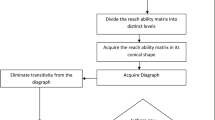Abstract
Lean manufacturing is an applied methodology of scientific, objective techniques that cause work tasks in a process to be performed with a minimum of non-value adding activities resulting in greatly reduced wait time, queue time, move time, administrative time, and other delays. In a cellular manufacturing system (CMS), machines are grouped into several cells, where each cell is dedicated to a particular part family and the objective is to maximize cell independence. CMS helps in reducing the material handling, work-in-process, setup time, and manufacturing lead time and improve productivity, operation control, etc. The facility layout used during lean implementation can be either be a line layout or in the form of cells. After grouping parts in to various part families, machine cells can be formed to produce those parts well inside the cells. As some of the lean manufacturing concepts are different from that of cellular manufacturing, e.g., establishment of Takt time, Takt-based resource balancing, etc., some new cell design methodology is required to be explored that is compatible with lean manufacturing. The rate at which work progresses through the factory is called flow rate or Takt. In the present work, a design methodology for cellular layout is proposed for implementing lean concepts and is exemplified in a manufacturing industry dealing with ammunition components for defense applications. Based on Takt time for various parts, the production flow among cells was optimized thus minimizing several non-value added activities/times such as bottlenecking time, waiting time, material handling time, etc. This case study can be useful in developing a more generic approach to design cellular layouts in lean environment.
Similar content being viewed by others
References
Gupta T, Seifoddini H (1990) Production data based similarity coefficient for machine-component grouping decisions in the design of a cellular manufacturing system. Int J Prod Res 28:1247–1269 doi:10.1080/00207549008942791
Hobbs DP (2004) Lean manufacturing implementation: a complete execution manual for any size manufacturer. J. Ross Publishing, Boca Raton
McAuley J (1972) Machine grouping for efficient production. Prod Eng 51:53
Pattanaik LN, Jain PK, Mehta NK (2007) Solving multi-objective cell design problem: an evolutionary genetic algorithm approach. Int J Manuf Tech Manag 11(2):251–273
Seifoddini H, Wolfe PM (1986) Application of the similarity coefficient method in group technology. IIE Trans 18(3):271–277
Seifoddini H (1989) A note on the similarity coefficient method and the problem of improper machine assignment in group technology applications. Int J Prod Res 27:1161–1165 doi:10.1080/00207548908942614
Wemmerlov U, Johnson DJ (1997) Cellular manufacturing at 46 user plants: implementation experiences and performance improvements. Int J Prod Res 35:29–49 doi:10.1080/002075497195966
Zhao C, Wu Z (2000) A genetic algorithm for manufacturing cell formation with multiple routes and multiple objectives. Int J Prod Res 38(2):385–395 doi:10.1080/002075400189473
Zolfaghari S, Liang M (1998) Machine cell/part family formation considering processing times and machine capacities: a simulated annealing approach. Comput Ind Eng 34:813–823 doi:10.1016/S0360-8352(98)00112-0
Author information
Authors and Affiliations
Corresponding author
Rights and permissions
About this article
Cite this article
Pattanaik, L.N., Sharma, B.P. Implementing lean manufacturing with cellular layout: a case study. Int J Adv Manuf Technol 42, 772–779 (2009). https://doi.org/10.1007/s00170-008-1629-8
Received:
Accepted:
Published:
Issue Date:
DOI: https://doi.org/10.1007/s00170-008-1629-8




